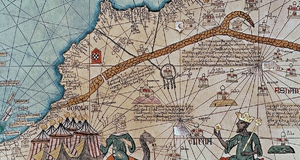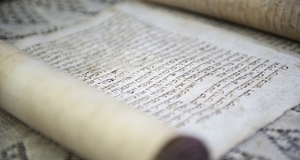Was Amir Khusrau a Historian? Examining his Work in a Contemporary Framework
By
2016, Vol. 8 No. 03 | pg. 2/2 | « Hardy goes onto explain how Khusrau’s position as a court historian influenced his writing of history. He wrote solely on the request of the Sultān (as he often writes in his works) and thus, he writes to a) impress the Sultān; b) present an ideal picture of the Sultān and his administration and c) silence any criticism he may have for the ruler or any of his policies. The influence of mysticism is very high on Khusrau, as Hardy argues, due to his close alliance with Nizāmuddīn Auliyā: In the final analysis, history, the actual event of the past, is unintelligible to Amīr Khusrau, except on the assumption that God wills everything. But his idea of Divine Causation is quite arbitrary, events happen, so to speak, by spontaneous combustion. Nor do they appear to happen through some process of human decision intended, according to the prevailing circumstances, to produce some humanly conceived situation.17 With regards to his life as a Sūfī, though, Hardy has his reservations:
This assessment comes back to the point how Khusrau had a rather overwhelming influence of mysticism; and he focused more on the aesthetics of writing rather than the historical dimension. All in all, he was a poet who wrote to impress the Sultān, his work being highly non-historic and more mystic, if one goes by what Peter Hardy has to say.19 However, we need to question that to what extent can we blame Khusrau for not matching up to the methods of history writing–he has never claimed himself to be a historian, and he is recording royal events mainly when he is asked to by his patrons.20 Thus, it was obvious for him to write in accordance with his patrons, because we cannot deny the importance of patrons for artists in medieval era throughout the world. Writing history was not his prime concern. Religion, love of art and literature, search for beauty and the fulfilment of his economic needs by legitimate means were his major concerns. On the same lines, Mohibbul Hasan observes:
And while writing he focussed his attention on events of social and cultural importance that he had witnessed. He widened the scope of Indo-Persian historiography by inventing new genres, writing history both in prose and verse. I.H. Siddiqui says that Khusrau had good knowledge of the early Persian writers who invented the genres22which were popular at that time, but Khusrau did not imitate any of these and invented his own prose style.23 Before Khusrau, Persian writers like Fakhr e-Mudabbir, Hasan e-Nizāmī and Minhāj-us-Sirāj and so on, had confined their narratives to descriptions of battles, conquests and court intrigues of the period. Khusrau shifts our focus to social and cultural aspects. I.H.Siddqui also states that he was the first Indian born historian and wrote from an Indian perspective. His work reflects a strong sense of identity with the country and Sultanate, emphasizes Siddiqui. No other has in Persian has written so widely and in such an imaginative way about India as Amīr Khusrau. Nūh Sipihr has an entire section providing encyclopaedic information on different aspects of Indian culture and the poet’s argument for his belief in the superiority of India in the Islamic world. He constructs various fanciful arguments to prove that India is akin to paradise and he lists seven reasons for the same. He then, gives a detailed description of India’s weather, and presents ten arguments for the same.
He even describes the languages of India and superiority of Indian languages. In Ghurrat al-Kamāl, he has mentioned that a scholar learning Turkish in Delhi could speak like pure Turks coming from Khurāsān. He then goes on describing different dialects in Hindustān and writes
However, it should be kept in mind that Amīr Khusrau is not engaged in a detached scholarly study of India like that of Al-Berunī, and some of his fanciful ideas must be understood in the context of his creative endeavour and the particular genre into which his work falls, as argued by Sunil Sharma.26 Although a view from the apex, there is popular lore and poetry in the common tongue that Khusrau has to his credit in the vast corpus of literature he has left behind. As far as his masnavīs are concerned, one must go back to Romila Thapar and A.L. Basham’s view that although there was no “history writing” in the modern sense in Early India, there was a historical consciousness present amongst the people. This is discernable from a close reading of the texts available to us and to read “between the lines,” as it were, of the primary sources of data. Thus, in that course of development of a historical consciousness from being “embedded” to a more modern or “externalized” historic consciousness, the Sultanate period lies, for me, somewhere in the middle; characterised by an intermingling of both embedded and externalized histories. It is in this context of development that the works of Amīr Khusrau and his contemporary writers are of great concern to us as historians. A rather orientalist vs. occidentalist aspect comes into the discourse as Peter Hardy demonstrates the bias of a classic Oriental scholar. It is difficult for a historian with such biases to appreciate the subtlety of statements in the masnavīs, as Mohibbul Hasan puts forth the argument. In the end, to summarise the importance of Khusrau as a source of history, a quote from Sunil Sharma:
On the standards of modern history-writing, Khusrau was not writing history. He was merely noting down the events with his own interests, comfort, superfluities, additions, omissions, slips, exaggerations, experiences and know-how. But while doing this, he left a huge amount data behind, which is of extreme importance for us modern historians. His style is full of exaggerations and metaphorical descriptions, but the facts of history are given with tolerable fidelity. It is now for us to bear in mind his biases and favours and then look at his masnavīs to reconstruct the history of the Sultanate. Because as E.H.Carr has uttered, “Before reading the history, read the historian.”28 Thus, as a person who is known by the common folk of north India even today, who was largely ignored, until recently, as a historian,29 Amīr Khusrau has indeed achieved what he meant to- “to leave something worthwhile and lasting behind him.”30 Endnotes1.) Man tu shudam, Tu man shudi–Hazrat Amir Khusro R.A., Retrieved from http://sufipoetry.blogspot.in/2009/05/man-tu-shudamtu-man-shudi-hazrat-Amīr.html 2.) Hindavi later developed into what is today known as Hindi in North India (especially in Western UP). 3.) Shahbaz Aamil Historical Value of Amir Khusrau’s Works: Qiran us-Sadain and Nuh Sipihr. Retrieved from http://www.aalamekhusrau.com/Shahbaaz%20Aamil%20pdf/Shahbaaz%20Aamil%20Wajifa-e-Khusro.pdf 4.) Interestingly, Nizāmuddīn Auliyā’, Khusrau’s spiritual master (pīr) called him the ‘Turk of God’. 5.) Amīr Khusrau had two brothers. 6.) It was at his grandfather’s place, that Khusrau met the young Sūfī Auliyā’ for the first time. 7.) Khusrau served Kishlū Khān, young prince Khān Malik Sultān Mohammad, Kaikūbād, Jalāluddīn Khiljī and Alāuddīn Khiljī. 8.) It is said that he wrote ninety-two separate works in all. If this is true, then we have lost a considerable portion of his work. 9.) A masnavī is a long narrative that is in the form of verses. It deals mainly with historical and romantic themes. The authors may (and often do) digress onto tangents in between their narration, which relate to, in the case of Khusrau, socio-cultural, ethnographic, linguistic and even botanical and zoological descriptions. 10.) Khusrau Dehlavi, Amīr In the Bazaar of Love : The Selected Poetry of Amīr Khusrau (ed. Sunil Sharma and Paul Losensky) (2011, Penguin Books) 11.) Ibid. 12.) A ghazal is a structured poem, which deals mostly with romantic themes. It often deals with a lot of emotions viz. love, anger, sadness etc. It is, of course, a very popular form of Urdu poetry today. 13.) Nizami, Khaliq Ahmad On History and Historians of Medieval India (1983, Munshiram Manoharlal Publishers Pvt. Ltd.) 14.) This explanation is of course, based on the post-Enlightenment Positivist understanding of who a Historian should be and; what his methods and objectives are, or ought to be. 15.) I. H. Siddiqui states that it is strange that Hardy did not pay attention to Mohammad Habib’s work on Khusrau. 16.) Hardy, Peter Historians of Medieval India: Studies in Indo-Muslim Historical Writings (1960, Luzac). 17.) Ibid. 18.) Ibid 19.) Notice how this analysis fits into Hardy’s larger categorization of medieval historians as theologians, who had little knowledge of writing history. 20.) In a Qasida, Khusrau tells one of his patrons: Even though I am the nightingale of words in the world’s rose garden, I flit about in this garden on the branch of your fortune. Don’t forget me where your kindness goes hunting, For crows and ravens eat the leftovers of royal falcons. 21.) Hasan, Mohibbul Historians of Medieval India (1968, Meenakshi Prakashan, Meerut) 22.) Khusrau in his writings, mentioned nine stylists. Sheikh Ali Hujuwir was one of them, his famous work Kashful Mahajib was the first work on Sūfīs and Sūfīsm ever written in Persian poetry. 23.) Siddiqui, I. H. Indo-Persian Historiography up to the Thirteenth Century (2010, Primus Books) 24.) Khusrau Dehlavī, Amīr Life, Times and works of Amir Khusrau (ed. Zoe Ansari, 1975, National Amir Khusrau Society, New Delhi) 25.) Ibid. 26.) Sharma, Sunil Amīr Khusrau: The poet of Sūfīs and Sultans: Makers of the Muslim World (2004, Oneworld Publication, London) 27.) Sharma, Sunil Amir Khusrau – The poet of Sufis and Sultans: Makers of the Muslim World (2004, Oneworld Publication, London) 28.) Carr, E.H. What is History? (1961, Random House, Inc., New York) 29.) Or Chronicler, as some may prefer. 30.) From Miftāh al Futūh Suggested Reading from Inquiries Journal
Inquiries Journal provides undergraduate and graduate students around the world a platform for the wide dissemination of academic work over a range of core disciplines. Representing the work of students from hundreds of institutions around the globe, Inquiries Journal's large database of academic articles is completely free. Learn more | Blog | Submit Latest in History |


















